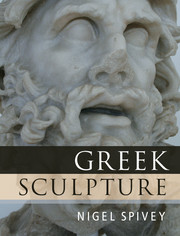Book contents
- Frontmatter
- Dedication
- Contents
- List Of Figures
- Preface
- Note
- 1 Introduction: the Study Of Greek Sculpture
- 2 The Greek Revolution
- 3 Daedalus and the Wings of Technê
- 4 Anathêmata: Gifts for the Gods
- 5 Heroes Apparent
- 6 Temple Stories
- 7 In Search of Pheidias
- 8 Revealing Aphrodite
- 9 Royal Patronage
- 10 Portraits and Personifications
- 11 Graecia Capta
- 12 Afterlife
- Index
2 - The Greek Revolution
Published online by Cambridge University Press: 01 December 2014
- Frontmatter
- Dedication
- Contents
- List Of Figures
- Preface
- Note
- 1 Introduction: the Study Of Greek Sculpture
- 2 The Greek Revolution
- 3 Daedalus and the Wings of Technê
- 4 Anathêmata: Gifts for the Gods
- 5 Heroes Apparent
- 6 Temple Stories
- 7 In Search of Pheidias
- 8 Revealing Aphrodite
- 9 Royal Patronage
- 10 Portraits and Personifications
- 11 Graecia Capta
- 12 Afterlife
- Index
Summary
Horses are not easy to represent (for one thing, they hardly ever stay still). Yet in the global history of art, horses must be one of the most common subjects of representation – beginning with Palaeolithic times. So it is with due regard to innumerable other images of horses that we may present one marble horse-head as emblematic of the extraordinary achievement of Greek sculptors in the Classical period: from the Parthenon pediments, the horse which seems to capture the essence of all horsiness (Figure 2.1).
A British clergyman, Philip Hunt, was among the admiring viewers of this sculpture as it made its way from Athens to London in the early nineteenth century. Hunt, who assisted Lord Elgin in the transfer of the Parthenon marbles, was unstinting in his eulogy of the piece, claiming that it ‘surpasses anything of the kind…in the truth and spirit of the execution. The nostrils are distended, the ears erect, the veins swollen, one might almost say throbbing. His mouth is open and he seems to neigh with the conscious pride of belonging to the Ruler of the Waves.’
This particular horse probably belongs to the chariot of a symbolic figure which is either Nyx (Night) or Selene (the Moon); and where Hunt saw urgent eagerness in its features, others register (more appropriately) a degree of equine fatigue. But niceties of interpretation apart, it is true to say that the response to this sculpture has been unequivocally enthusiastic, to the extent that it is referred to as the Urpferd – the original horse, the horse-archetype – a horse by which all other horses, in art or in life, must be measured.
This is extraordinary, absolute praise for a work of art. It can be traced directly to the German Romantic Goethe (1749–1832), who became somewhat obsessed with finding Ur-forms in other fields: an Urpflanze, for example, ‘the primal plant’, from which all plant varieties must be descended. Referring simply to ‘the Elgin horse-head’ in one of his essays on morphology, Goethe asserted the statue to be so overpowering and yet ‘ghostly’ in appearance that if you compared it to horses in nature, you could only conclude that the sculptor had created ‘the primal horse’.
- Type
- Chapter
- Information
- Greek Sculpture , pp. 16 - 53Publisher: Cambridge University PressPrint publication year: 2013



